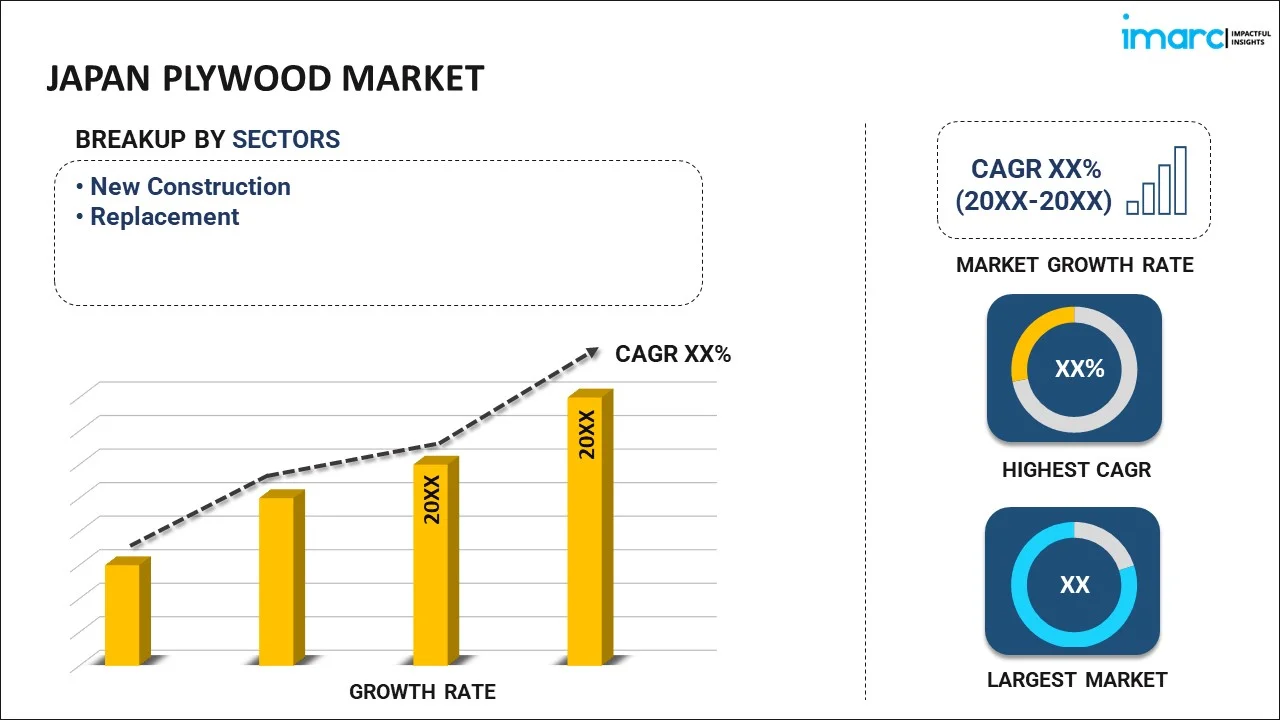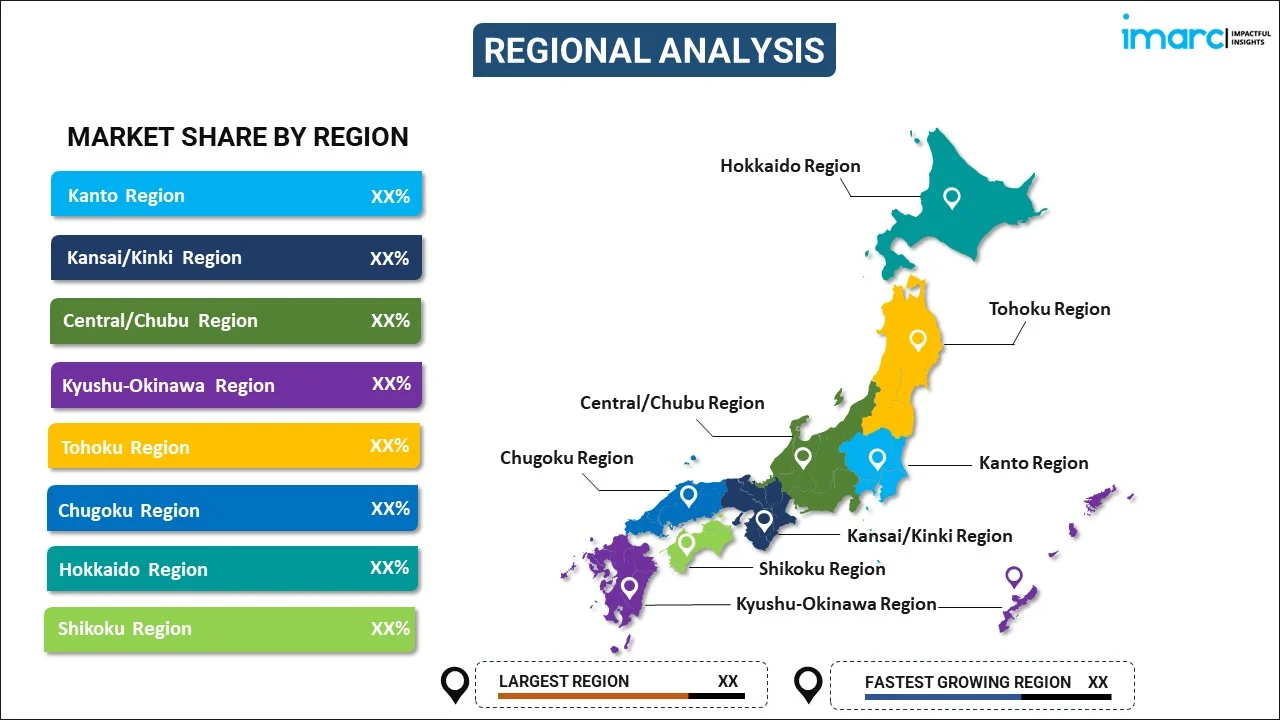
Japan Plywood Market Report by Sector (New Construction, Replacement), Application (Residential, Commercial), and Region 2025-2033
Market Overview:
Japan plywood market size reached USD 2.5 Billion in 2024. Looking forward, IMARC Group expects the market to reach USD 3.5 Billion by 2033, exhibiting a growth rate (CAGR) of 3.61% during 2025-2033. The increasing innovations in plywood manufacturing techniques, such as engineered wood products like laminated veneer lumber (LVL) and particleboard, that can offer alternatives or improvements in terms of strength, durability, and cost-effectiveness, are driving the market.
|
Report Attribute
|
Key Statistics
|
|---|---|
|
Base Year
|
2024 |
|
Forecast Years
|
2025-2033 |
|
Historical Years
|
2019-2024
|
| Market Size in 2024 | USD 2.5 Billion |
| Market Forecast in 2033 | USD 3.5 Billion |
| Market Growth Rate (2025-2033) | 3.61% |
Plywood is a versatile engineered wood product widely used in construction, furniture, and various other applications. It is composed of multiple thin layers of wood veneer, called plies or layers, bonded together with adhesive under high pressure and heat. These plies are typically arranged with their grain directions perpendicular to one another, creating a strong and stable composite material. Plywood comes in various grades, with each grade tailored to specific uses. Higher grades have fewer defects and are suitable for applications where appearance is important, such as cabinetry and furniture making. Lower grades are more cost-effective and are often used for structural purposes in building construction. One of plywood's key advantages is its strength-to-weight ratio, making it ideal for sheathing walls and roofs, subflooring, and as a base for flooring and tiling. It is also highly resistant to warping and splitting, ensuring long-term durability. In summary, plywood is an engineered wood product that offers strength, versatility, and stability, making it an essential material in a wide range of industries and applications.
Japan Plywood Market Trends:
The plywood market in Japan is experiencing robust growth due to several interconnected factors. Firstly, the construction industry's resurgence has played a pivotal role in driving demand for plywood. As urbanization continues to surge, the need for residential and commercial infrastructure has led to increased consumption of plywood in applications such as roofing, flooring, and wall paneling. Furthermore, the versatility of plywood as a building material, offering strength, durability, and cost-effectiveness, has further propelled its demand. Moreover, the growing trend towards sustainable and eco-friendly construction practices has boosted the market. Plywood, being sourced from sustainably managed forests and often produced using eco-friendly adhesives, aligns with this preference. Additionally, the surge in home renovations and DIY projects has led to a surge in demand for plywood as homeowners seek to enhance their living spaces. Apart from this, the expanding furniture industry, which utilizes plywood for crafting diverse furniture designs due to its adaptability and ability to withstand various finishing treatments, is expected to drive the plywood market in Japan during the forecast period.
Japan Plywood Market Segmentation:
IMARC Group provides an analysis of the key trends in each segment of the market, along with forecasts at the country level for 2025-2033. Our report has categorized the market based on sector and application.
Sector Insights:

- New Construction
- Replacement
The report has provided a detailed breakup and analysis of the market based on the sector. This includes new construction and replacement.
Application Insights:
- Residential
- Commercial
A detailed breakup and analysis of the market based on the application have also been provided in the report. This includes residential and commercial.
Regional Insights:

- Kanto Region
- Kansai/Kinki Region
- Central/ Chubu Region
- Kyushu-Okinawa Region
- Tohoku Region
- Chugoku Region
- Hokkaido Region
- Shikoku Region
The report has also provided a comprehensive analysis of all the major regional markets, which include Kanto Region, Kansai/Kinki Region, Central/ Chubu Region, Kyushu-Okinawa Region, Tohoku Region, Chugoku Region, Hokkaido Region, and Shikoku Region.
Competitive Landscape:
The market research report has also provided a comprehensive analysis of the competitive landscape in the market. Competitive analysis such as market structure, key player positioning, top winning strategies, competitive dashboard, and company evaluation quadrant has been covered in the report. Also, detailed profiles of all major companies have been provided.
Japan Plywood Market Report Coverage:
| Report Features | Details |
|---|---|
| Base Year of the Analysis | 2024 |
| Historical Period | 2019-2024 |
| Forecast Period | 2025-2033 |
| Units | Billion USD |
| Scope of the Report | Exploration of Historical Trends and Market Outlook, Industry Catalysts and Challenges, Segment-Wise Historical and Future Market Assessment:
|
| Sectors Covered | New Construction, Replacement |
| Applications Covered | Residential, Commercial |
| Regions Covered | Kanto Region, Kansai/Kinki Region, Central/ Chubu Region, Kyushu-Okinawa Region, Tohoku Region, Chugoku Region, Hokkaido Region, Shikoku Region |
| Customization Scope | 10% Free Customization |
| Post-Sale Analyst Support | 10-12 Weeks |
| Delivery Format | PDF and Excel through Email (We can also provide the editable version of the report in PPT/Word format on special request) |
Key Questions Answered in This Report:
- How has the Japan plywood market performed so far and how will it perform in the coming years?
- What has been the impact of COVID-19 on the Japan plywood market?
- What is the breakup of the Japan plywood market on the basis of sector?
- What is the breakup of the Japan plywood market on the basis of application?
- What are the various stages in the value chain of the Japan plywood market?
- What are the key driving factors and challenges in the Japan plywood?
- What is the structure of the Japan plywood market and who are the key players?
- What is the degree of competition in the Japan plywood market?
Key Benefits for Stakeholders:
- IMARC’s industry report offers a comprehensive quantitative analysis of various market segments, historical and current market trends, market forecasts, and dynamics of the Japan plywood market from 2019-2033.
- The research report provides the latest information on the market drivers, challenges, and opportunities in the Japan plywood market.
- Porter's five forces analysis assist stakeholders in assessing the impact of new entrants, competitive rivalry, supplier power, buyer power, and the threat of substitution. It helps stakeholders to analyze the level of competition within the Japan plywood industry and its attractiveness.
- Competitive landscape allows stakeholders to understand their competitive environment and provides an insight into the current positions of key players in the market.
Need more help?
- Speak to our experienced analysts for insights on the current market scenarios.
- Include additional segments and countries to customize the report as per your requirement.
- Gain an unparalleled competitive advantage in your domain by understanding how to utilize the report and positively impacting your operations and revenue.
- For further assistance, please connect with our analysts.
 Inquire Before Buying
Inquire Before Buying
 Speak to an Analyst
Speak to an Analyst
 Request Brochure
Request Brochure
 Request Customization
Request Customization




.webp)




.webp)












